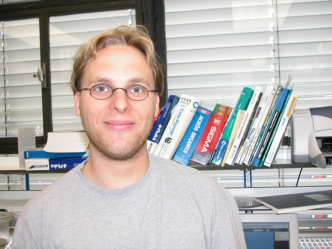Fabrication of photonic crystals and nanocavities
Promotion date: 5. September 2008
Promotor: Prof dr. Willem Vos
Assistant promotor: Dr. Willem Tjerkstra
| In this thesis several fabrication methods were investigated to obtain three-dimensional photonic crystals, in particular inverse woodpiles. Three-dimensional photonic crystals are predicted to be ultimate devices to completely control the propagation and emission of light. This is highly anticipated for applications in information communication and processing, but may also yield sensitive sensors useful for biology and even medicine. By optimizing the parameters of a reactive ion etching process, excellent quality pores of air in silicon were realized with world-record aspect ratios. Optical reflectivity experiments confirmed the high quality of the realized 2D photonic crystals. As a next step, a prototype 3D structure was fabricated. The realization of this structure and its high optical reflectivity cause confidence that soon the first inverse woodpile photonic crystals with large photonic band gaps will be realized. In this project we have collaborated with researchers from ASML (the world's leading manufacturer of lithography systems for the semiconductor industry) and from Philips Research. Furthermore, a new method is reported to obtain cavities in opal photonic crystals. We used a finely focused ion beam to drill tiny holes in individual nanospheres. The fabricated nano-sized point defects are shown to interact with light of many wave vectors. Therefore they are promising to be used to obtain optical microcavities that trap light. |
How can you tell the fabricated photonic crystals are so promising?
The pores of air that were etched in the silicon wafers have a high quality and have world record aspect ratios (the ratio of depth to diameter). These pores have typical diameters of the order of the wavelength of light, around 300 nm, with interpore distances of about 500 nm.
In case of the fabricated 2D photonic crystals, the measured reflectivity peaks are high and broad, which indicates both an excellent crystal quality and a strong interaction with light. By etching pores in two directions, 3D structures can be made. These structures are expected to have a large photonic band gap.
How complex is the other technique of making defects in opal photonic crystals?
To make the starting opal is not difficult at all, since it is made by self-assembly of high quality nanospheres. Making effective point defects in these SiO2-structures using the focused ion beam turns out to be less straightforward than expected. It is necessary to treat the opal with carbon to make it a conducting structure in which to mill defects in a carefully controlled way. We are pleased that the method has later also been used by other MESA+ groups.
What are your future plans?
As a post-doc I am working on the etching methods to drill holes in two directions. We want to use methods that are compatible with methods used in the IC industry. For a long time already, we are working with ASML on this.
Besides, I have just finished a scientific paper in which we present elaborate calculations on these structures. The main question addressed in this paper is to estimate how deviations in the structure influence the photonic band gap properties of inverse woodpile photonic crystals. This knowledge aids in process selection and process development.
At the moment I am busy applying for a job in the Netherlands. I am looking at jobs in academics and at jobs with a strong research component in a company environment.
To stay successful in the future, what is, in your opinion, important for MESA+?
Stimulating interpersonal contacts can have considerable added value. In principle it is possible to look at the websites of all individual groups within MESA+ to find out about the work of our colleagues. However, I think it is more efficient to have a specialized intermediate person who can find research partners within MESA+ in a structured way. At this time this mostly happens merely as a result of coincidence.
Also, investing in good facilities stays of great importance. Although there is a lot of good technology available at MESA+, during the course of my project a working e-beam was not available which caused considerable delays in my research.

